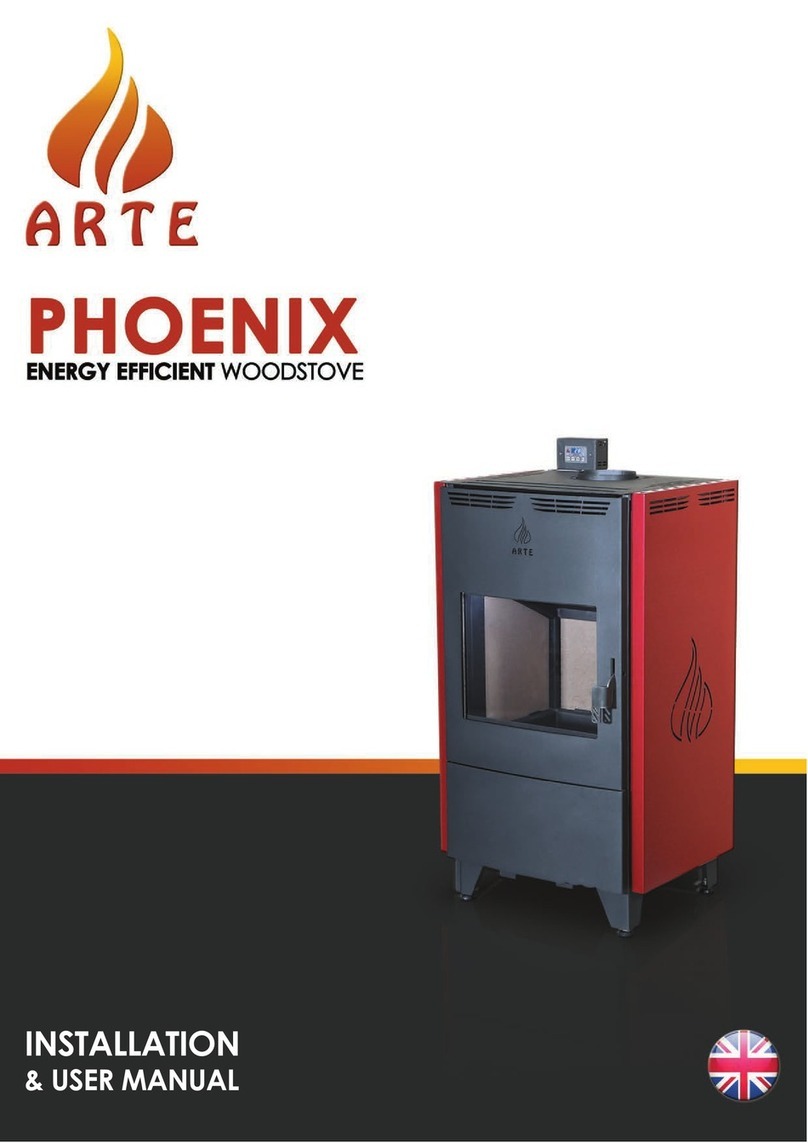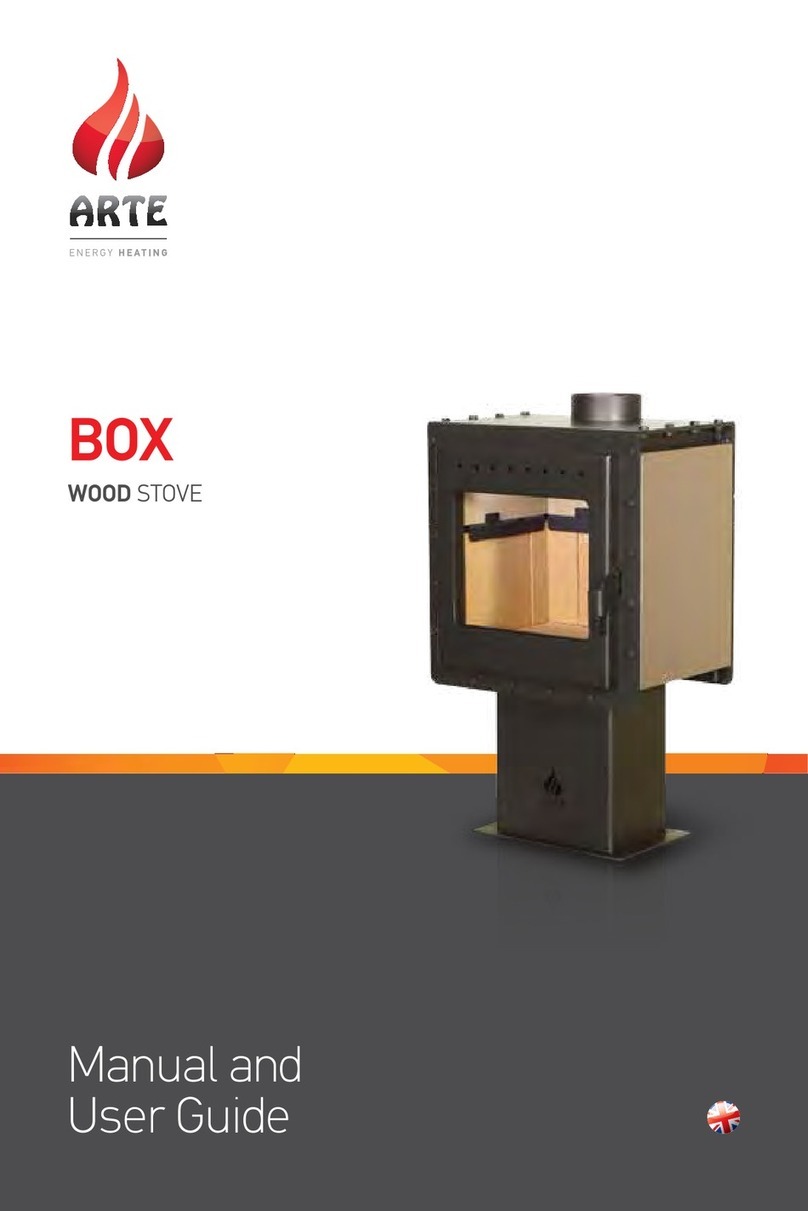
6.6.1 Electronic board and use of it
>ON / OFF:
The On/Off of the controller is pushing the button A
The state OFF is signaled through the led L1
>FUNCTIONING Modality
MANUAL: advice signal MAN
The fan is at the set speed independently by the Probe’s temperature.
AUTOMATIC: advice signal AUT
The Fan starts at the set up speed when the probe’s temperature is higher than the setted Thermostat
(45oC).
PROPORTIONAL: advice signal PROP
The fan increases automatically its speed according to the probe’s temperature (from 45oC plus).
If you forget to open the thermostat (OFF) when you had lighted the stove and the probe’s temperature
is becoming higher than 100oC the device goes in ON automatically in MANUAL Modality, and after 10
seconds the device goes automatically in the Proportional Modality until the temperature will become
(90oC) and it is going again in MANUAL Modality. It’s going to repeat this function again and again until
you select another function.
ALARM Function: if probe’s temperature is higher than (130oC) an acoustic signal is activated. This
signaling can be deactivated for 5 minutes by pushing a button. After 5 minutes, if there’s again the
condition of alarm, it is activated again.
>Main MENU:
FUNCTIONING Modality Selection
Press Dkey to see the current modality: it’s signaled by the display and the led. Pressing again the D
key, you can select cyclically one of three functioning modality signaled on the display and by the led.
The setting is automatically memorized after 4 seconds
The L5 shows the status of the Fan
Functioning Speed Selection
Pressing B or C keys the setting of the current fan speed is visualized or modified P0 = OFF (only
manual); P1 = Min. Speed; P10 = Max. Speed
This function is not available in the PROPORTIONAL Modality
In the AUTOMATIC Modality the speeds that can be set are P1 ÷ P10
>FAILURE OR ALARM SIGNALS
The controller can signal the failure of the probe. Blinking message for the failure signal:
Lo: indicates a low temperature (temperature under 0°C): Probe Open or Disconnected
Hi: indicates a high temperature (temperature over 180°C): Probe in Short Circuit
7. FIRING THE STOVE
7.1 Traditional firing
When first lighting the stove, a large volume of air is needed. When the stove is cold, you should leave the door
open to the first latch so there is an air gap around it (or if you do not have a handle with two latch, 1 - 2cm ) for
the first few minutes and open the primary & secondary air supply completely.
To form a reasonable bed of ash on the floor of the stove, you should use 1 - 2 kg of dry kindling at the ini-
tial lighting. If possible, maintain a 2 - 3 cm layer of ash on the floor of the combustion chamber for added
insulation.
1. Put 2 - 4 fuel tablets or 7 - 10 rolled up sheets of newspaper underneath 1 - 2 kg of dry kindling
2. Open the primary & secondary air by pulling it out all the way (Fig.4 A&B)
3. After the fuel tablets/rolled up sheets have caught fire, leave the fire door ajar about 1 - 2 cm (or to the
first latch of handle), so that the chimney draws well
4. When you can see that the chimney is hot enough to draw (after 5 - 10 minutes), close the door. If all the
necessary conditions are met, a thick layer of embers will have been formed in the combustion chamber
after another 15 - 20 minutes, and there will be a high temperature in the combustion chamber, which
is necessary in order to be able to continue the combustion.
5. If the condition in step 4 is met, place 2 - 3 pieces of wood with a total weight of 1.5 - 3 kg over the embers,
with a distance of approximately 1 cm
6. Open the air supply to maximum, and close the door. The fresh wood will be lit within 2 - 3 minutes. If it
does not light, open the door slightly to allow in enough air to ignite the wood. Close the door again once
the wood has caught. Also close the primary air.
7. Reduce the amount of secondary air to the desired position, and the optimal combustion will continue.
Make sure that there is always enough air (oxygen) to maintain clear, lasting flames when, and after,
reducing the amount of combustion air.
8. Once the fire has been reduced to a thick layer of embers, a new portion of wood can be added by repeat-
ing steps 5 & 7
7.2 Firing the stove without CO emissions (TOP-DOWN)
1. Open the primary & secondary air by pulling it out all the way (Fig.4 A&B). If necessary, keep the door
slightly open about 1 - 2 cm (or to the first latch of handle).
2. Place 2-3 pieces of wood with a total weight of 1.5 - 3 kg and a length of 30 - 35 cm in/out on each side of
the base. (Fig. 9 A&B)
While the door is open, do not leave the stove unattended
40 |41
APOLLO WOOD STOVE
In order to avoid sooting on the glass, it is important that the
log is not placed adjacent to the glass on the product
L1
L2
L3
L4
L5
A B C D






























